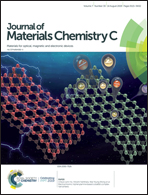An optical perspective on the thermal-activated ionic migration state and ionic jumping distance in glass†
Abstract
Ion migration is a fundamentally important process upon activation by external temperature or an electric field in ionic conductors, and it is also common in opto-functional materials like lasing glass caused by heat accumulation. It is prerequisite to investigate the thermal-driven ion migration process, analogous with the defect generation or annihilation. An optical approach with upconversion (UC) luminescence of Er3+ is used to reveal the ionic migration state and the jumping distance in the Na+-conducting glass of Yb3+/Er3+-doped SiO2–CaO–Na2O. The apparent break point at ∼150 °C in the intensity ratio of green and red emission versus temperature can show the ignition of Na+ motion, as evidenced by various characterization techniques. And this should be ascribed to a distinct non-radiative rate from the green emitting level to red emitting level versus temperature in the ionic migration state of glass. The Na+ jumping distance is ∼1.8 Å estimated by using the electric method, roughly coincident with the result deduced by the optical sensing approach. The dynamic migration of Na+ would adjust the bond angle and bond length of the Si–O bridging network and relax the mother host structure of the glass, according to the 29Si nuclear magnetic resonance data. This research gives an alternative perspective on thermal-activated ion migration via an optical approach.



 Please wait while we load your content...
Please wait while we load your content...